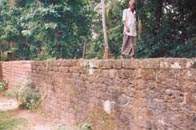| Plus |
|
|||
|
Big battle to
save Kotte's ruins
"The
Kotte period lasted from 1400 to about 1597," explains Mr.
A. E. L. Tillekewardene of the Archaeological Department. It was
first used as a fortress and then as the capital. The fortress city
was initially built to resist invasions from the north, by minister
Alakeswara, appointed by the King of Gampola. The potential of the
natural geographical surroundings of the Diyawanna Oya, marshlands
and forests, was recognized and utilised to the full, transforming
Kotte into a fortress city, surrounded by water. According to
the Journal of the Ceylon Branch of the Royal Asiatic Society (JCBRAS),
in the beginning there was only a fortress, which served as a safe
place. But when Alakeswara consulted Ven. Vidagama at a later period
for his crown, the priest told him, "A great capital should
be built to hold so great a king, and till then he should not be
crowned." Hence, during the three years of his dictatorship,
to fulfil the condition and get the chief priest to perform the
rite, Alakeswara added to and improved his city of Kotte, converting
it from a fortress into a magnificent capital with stone baths and
cisterns, spacious streets and fine edifices.
Parakramabahu
VI was the most important monarch of Kotte. During his time, Ceylon
was reunited as one kingdom with the capital at Kotte. Stability was
the main reason for Kotte to develop as it did culturally and economically.
The king being a poet himself, encouraged arts and culture. Several
religious buildings were constructed as well as five educational
pirivenas. The later capitals
such as Kotte remained centres of population unlike the more ancient
cities like Anuradhapura and Polonnaruwa, where archaeological sites
were protected by the surrounding jungle. Thus much of what remained
of the old city of Kotte was obliterated by urbanisation. With the
moving of the parliament to Kotte, the value of land also rose,
resulting in more new constructions over the old sites. Also the
construction during the Kotte period is found to be largely of kabook
or laterite found in the area, and wood, and less of stone which
is more long lasting.
Mr.
Tillekewardene explained that archaeological research and contemporary
literature have indicated what the city of Kotte was once. It has
been established that a fortified wall surrounded the city. Inner
and outer moats were built only on the south side. According to
Antiquities of the Kingdom of Kotte, the lower end of the ramparts
reveal that its construction was on two tiers. Look out towers were
also there. A terrace, 10 feet in width runs between the two embankments,
which is a rampart walk, intended for sentinels on guard duty. "The
city was adequately protected on the north, west and east by the
Diyawanna Oya, its treacherous marshes teeming with alligators.
The ramparts and inner moat were constructed to link up with the
Diyawanna Oya and protected the vulnerable south side of the city."
Six entrances to the city are mentioned. Today, some
portions of the fortress wall can be seen. On the south side, deep
ditches which had been the moats are also visible. The area bounded
by the fortress and inner moat is now Ethul Kotte. The area between
the inner moat and outer moat is Pita-Kotte. The wall has been declared
a protected monument and there is a building reservation within
10 feet outside the wall and five feet inside the wall. However,
Mr. Tillekewardene explained that some of the lands are privately
owned and there are difficulties in implementing the Archaeology
Act. The Archeology Department clears portions of the wall, depending
on the availability of funds. To clear the wall completely, some
buildings need to be relocated. In the meantime,
the UDA has started a survey to identify the properties which obstruct
the wall. The two moats have been gazetted as Archaeological Reserves.
No construction is permitted in these areas. The only monument
existing in a fairly good condition is Veherakanda at Beddegana,
where ruins of two stupas have been excavated in 1949. Veherakanda
was declared an archaeological reserve in 1948. The Archaeological
Department plans to make it an exhibition site. Another archaeological
reservation is the Alakeswara tomb or palace. Recent research shows
that there had been several buildings and these were likely to have
been the palace, that he built in order to get the crown. This site
is said to be the highest spot in Kotte. According to JCBRAS, "Here
also stands, or rather stood till recently, the granite coronation
platform of the kings of Kotte, overlooking the tank, where Alakeswara
was assassinated." Not much remains of the buildings. The only other visible archaeological site in the area is the ambalama, which stands by the main road. Research has established this structure to have been erected in the late 19th century, during the British period. With the road widening, it is planned to conserve the building by moving it seven feet back. According to an official of the UDA, preservation of ruins is difficult in well populated areas like Kotte, unless the Rampart project is combined with another environmental project so that it can be fitted into the modern city trends. |
||||
Copyright © 2001 Wijeya Newspapers
Ltd. All rights reserved. |


